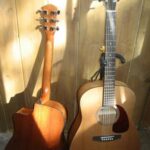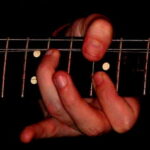Ever since I started playing guitar, I wanted what every guitarist really wants; a true Gibson Les Paul, not a cheap knockoff. I had played mostly Stratocasters, both Fenders and copies made by foreign manufacturers. They are cheaper, sound great for the money, and you don’t feel so bad about stepping on one or spilling beer on it at a gig. That is not a slur on Strats, because true Fender Stratocasters are fine guitars. Their only problem is they’re not Les Pauls!
Only a Les Paul has that fat, cinder block-smashing tone and that silky-smooth, endless sustain. Listen to recordings by Led Zeppelin, Kiss, Guns n’ Roses, the Cult, Randy Rhoads, Lynyrd Skynyrd, and the Allman Brothers, and you can hear the common thread that runs through the music of each of these great bands. It is the unmistakable sound of the guitar that bears the name of the man who changed the guitar and modern music forever!
Problem is, though, a real Gibson Les Paul costs between $1,200 and $5,000. No trailer park boy could afford one, and if he had one, either a rich relative bought it for him, or it was hot (usually the latter, unfortunately). Seriously, how could you justify buying a guitar that was worth more than your car, or maybe even your trailer?
Well, thanks to Epiphone, it is possible for anybody to own a true Les Paul. Epiphone was started in 1915 in New York City by a family of Greek immigrants. By 1950, Gibson’s parent company, Chicago Musical Instrument, bought the company for $20,000, and made it a division of Gibson. By 1986, after decades of making its mark with its own line of guitars like the Sheraton, Emperor, and Casino models (endorsed by such luminaries as Ernest Tubb, Grady Martin, and the Beatles), Epiphone made versions of Gibson classics such as the SG, Flying V, Explorer, and, of course, the Les Paul.
Built to the same exact standards and from the same materials as Gibson models, the only difference is that Epiphones are mass produced overseas, while Gibsons are hand made in the United States. Thanks to the lower production costs, now almost everybody can have true Gibson sound without taking out a second mortgage.
My wife got me mine for my birthday in 2004. She knew I always wanted one, so when she saw them on sale at Guitar Center for $599.99, she took our income tax return check for that year, and surprised me at work, and what a surprise!
She picked out one with a honeyburst finish. In my four years in the furniture business, I have never seen a piece, regardless of price, with a finish as beautiful and durable as that guitar. The carved top, made of bookmatched AAA flame maple, shimmered like abalone, its silvery tiger stripes glowing in the sun as I checked it out in the parking lot. The mahogany back was a deep, rich reddish brown with a tight, jet black grain, with the neck made of the same beautiful, exotic wood.
It had cream colored binding to seal the fingerboard and the edges of the body, and gleaming chrome hardware. The rosewood fingerboard had the standard trapezoid “crown” fret inlays made of mother of pearl, with jumbo nickel-silver alloy frets with rounded tops. The headstock was the only physical difference between my Epiphone and a Gibson, but still had the dark, shiny black finish, the brand name set with mother of pearl, the precision sealed Grover tuning machines, and, of course, the golden signature of the master himself.
When I took it home and plugged it in to a Marshall JCM 100, there was that classic Les Paul sound I had waited years to call my own! After all, it has everything the Gibson version has, including the chrome alnico humbucking pickups. It has the slim Gibson neck (1.68″ at the nut) and the short 24.75″ Gibson scale, which makes it easy to overplay if you’re used to the standard 25 inch scale found on other guitars, including Stratocasters.
It does feel pretty heavy around your neck (it IS a Les Paul, after all!), but that weight is offset by a very nice balance that reduces fatigue. And, to my ears, the sound is IDENTICAL to the Gibson Paul (though some players claim to be able to tell a very slight difference between the two). The neck pickup provides a warm, mellow sound, especially when played through a clean channel, and the bridge pickup is very sharp and edgy, especially when playing distorted leads. They can be played individually or blended together with the toggle switch located on the upper bout. The patented Gibson Tune-O-Matic bridge, bolted right into the body, and the glued-in set neck, help create that monster tone and endless sustain.
Minor discrepancies in craftsmanship are the only true differences between the Epiphone and Gibson instruments. The Epiphone, mass-produced overseas, does have minor imperfections that do not appear on the meticulously hand-crafted Gibson model. The volume knobs tend to be set very close to the body, even rubbing the finish. Likewise, some of the retaining nuts on the tuning posts were loose, as well as the screws in the pickguard and the nut on the input jack.
Don’t let that fool you, though, as these are minor things that are easily corrected by anybody who can use screwdrivers and pliers, but PLEASE use extreme care so as not to ruin that remarkable finish! In the end, the only true difference between the two models is bragging rights.
Normally, on principle, I’d buy the American made Gibson model in a heartbeat, but thanks to Epiphone, anybody can have that killer sound that made legends of Jimmy Page, Pete Townshend, Ace Frehly, Tom Sholz, Randy Rhoads, Slash, Zack Wylde, Duane Allman, and Alex Lifeson, because not all of us have $1,200 of “principle” just lying around waiting to be spent!






